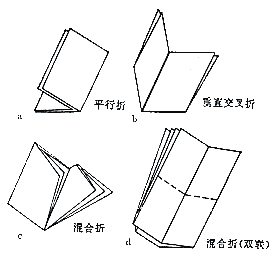The binding process of paperback books is divided into book block processing and bag cover, and the process flow: cutting → folding → arranging → book packaging → cutting books. From cutting to stapling is the core processing stage.
(A) book block processing
â— 1. Cutting
According to the requirements of the next process, the printed semi-finished products are cut into the required specifications on the single-sided cutter. The printed semi-finished product may be a printed copy of a book, an illustration, a cover sheet, a cover, and the like.
â—2. folding
The process of folding large pages of printed pages into pages in the order of page numbers and the specified width is called folding. For the binding of any book, the first step is to fold the large-format page into a signature. For the next process.
The folding method can be roughly divided into three types:
(1) Vertical cross folding method
When the folds of one fold and the other fold are perpendicular to each other, this folding method is called vertical cross folding (Figure 8-15b).
The features of folding into signatures using the vertical cross folding method are:

1 The folds of two adjacent folds are vertical, and the folds of the book are read with folds, one fold and two folds, two folds and three folds, and the folds between three folds and four folds are perpendicular to each other and cross each other.
2 The processing is convenient, and the processing of each process such as folding, sticking, collating and stapling of signatures is convenient.
3 discounts are proportional to the number of pages, and the number of discounts and pages and the number of pages have certain rules.
Most books now use this folding method.
(2) Parallel folding method
The folding method in which two adjacent folds are in a parallel state is called a parallel folding method, Fig. 8-15a. Generally suitable for relatively thick paper prints, such as children's books, pictures, pictures and so on.
(3) Mixed folding method
In the same page, the creases of each fold are both vertical and parallel. This type of folding is called mixed folding, also known as integrated folding (8-15c). Most of the signatures folded by the machine are Forms.
According to the different folding methods of the signatures, various different forms such as positive folding (Fig. 8-16a, smooth folding) and reflexive folding (Fig. 8-16b), single-linking and double-linking (Fig. 8-17) can be further divided.


The folding has manual folding and mechanical folding.
At present, every book and periodical printing factory has used machinery instead of manual folding. However, it often encounters small-batch products, special-sized products, or reworked and repaired products. At this time, manual folding is still required.
Machines that use machinery instead of manual folding machines are collectively referred to as folding machines.
The folding form of the folding machine is basically divided into three types:
(1) Fence folding machine
The pages to be folded are fed one by one to the two folding rollers that rotate inwards simultaneously (Figure 8-18b). As the folding roller rubs against the printed sheet, the printed sheet moves forward along the upper fence track and is sent to the fence gauge installed in the fence. Under the continued friction of the folding roller, the printed sheet is forced to fold and continue after turning. Move forward until it reaches the lower fence gauge, complete the first fold. As the folding roller rotates to complete a folded paper, it is forced to bend again, and is then sent out by the folding roller. This completes the two-fold signature, and proceeds to a three-fold, four-fold signature.
Fence type folding machine is characterized by small body, high speed, and convenient operation, but it can be folded smaller, the processed paper should not be too thin, otherwise it will affect the folding accuracy.
(2) knife folding machine
The folding mechanism is a paper knife pressed into the continuous rotation
Figure 8-18 Machine Folding Diagram

Between the two folding rollers to complete the folding process, at the same time, the paper moves along with the conveyor belt and is sent to the second folding and third folding position, and finally is folded into a signature.
The working process of the knife folding machine is shown in Figure 8-19.

1—folding; 2—pages 3—plyboards; 4—rules; 5—folding rollers
Figure 8-19 Schematic diagram of the knife folding process
Knife folding machine is characterized by: 40 ~ 1oo g / m2 full sheet of paper or folio automatically folded into a variety of commonly used specifications of the signature; folding accuracy is relatively high, more convenient operation.
(3) Grid knife hybrid folding machine
The folding mechanism of the same folding machine has both knife type and fence type. This is called a grid knife folding type folding machine. The folding speed of the folding type folding machine is faster than that of a knife folding type. Minutes up to 120 posts or so.
(to be continued)
Jingyi Plastic Industrial Co., Ltd. , http://www.yymakeuppackaging.com